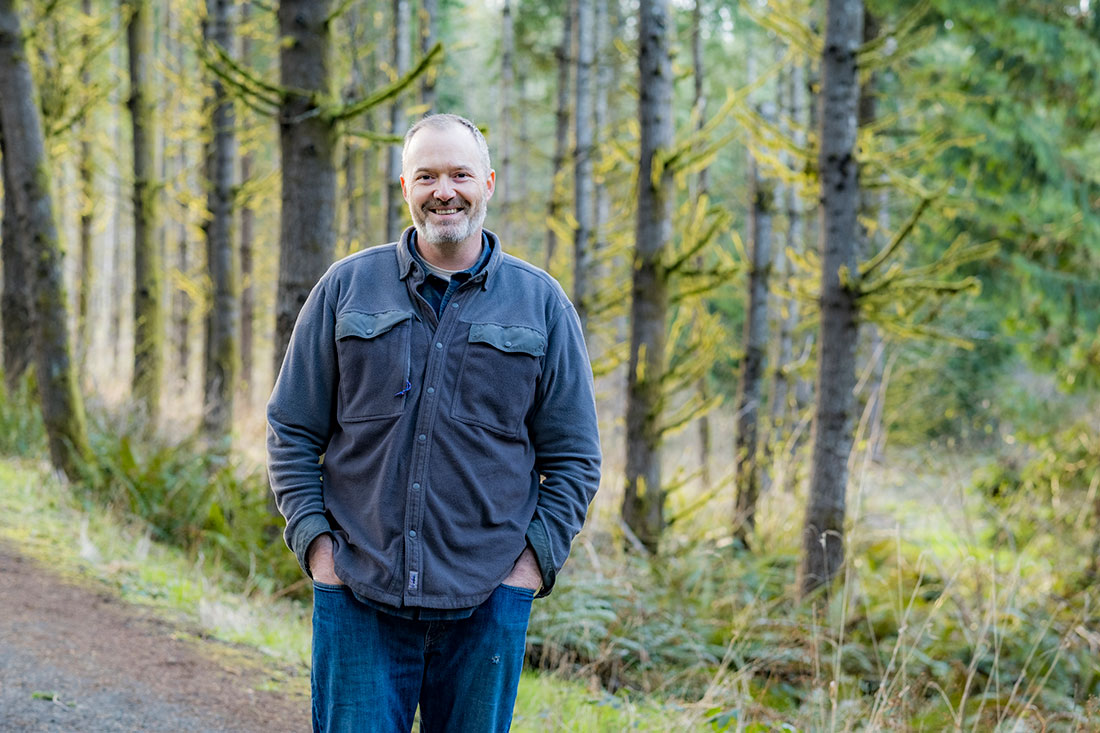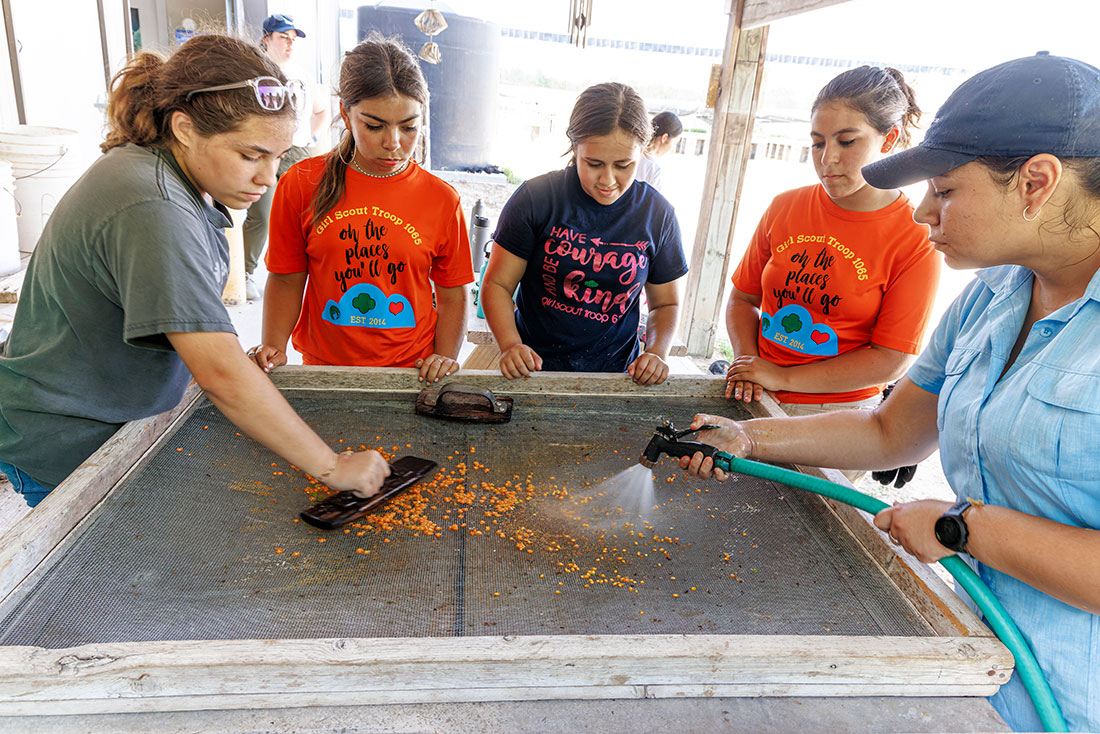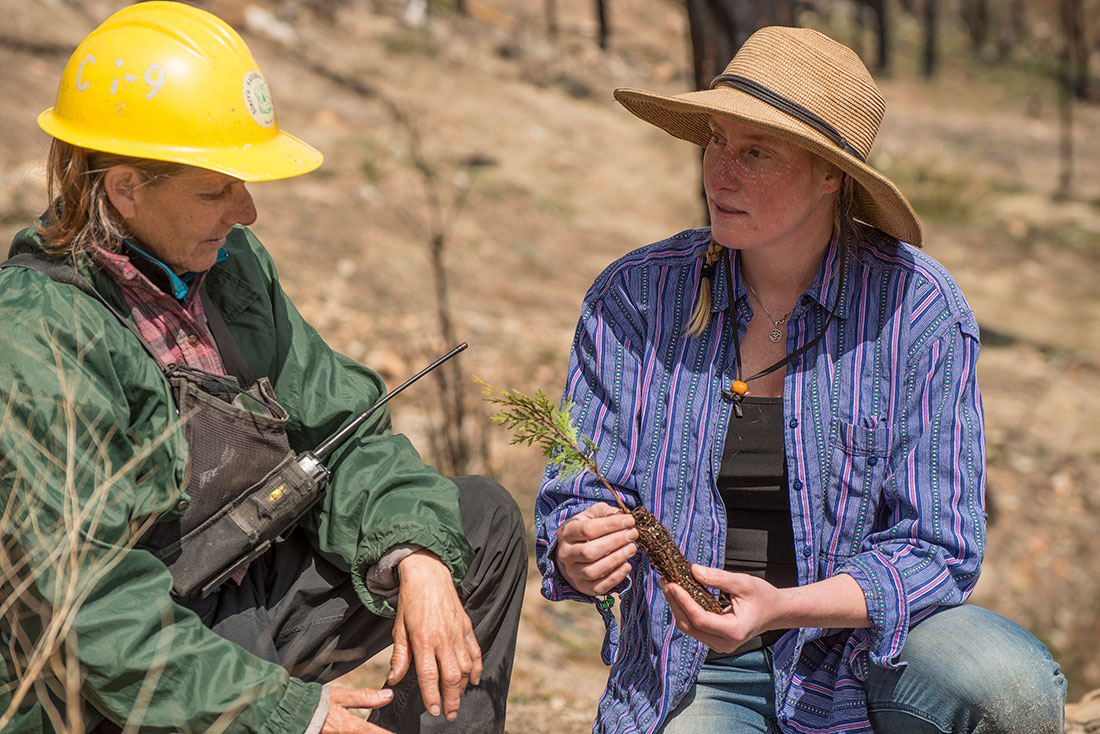LUIS VIDAL SHOULD BE USED TO THIS BY NOW. Wildfires are an ever-present threat in the Sierra Nevada Mountains where he currently lives, and the wildfire season is no longer restricted to the dry, hot summer months. So he was surprised to find a lump in his throat as he watched from afar as the massive Mosquito Fire bore down on his current home at the U.S. Forest Service ranger station, where he works as the Northern California reforestation manager for American Forests.
He was tracking the fire’s progress from his parents’ home in Utah. The fire maps showed the flames getting perilously close to a stand of rare Ponderosa and sugar pine trees. The latter are among the 3% to 5% of this species that are genetically resistant to white pine blister rust, an invasive fungus from Asia that is laying waste to these trees across the West.
He was relieved that luck had been on his side just a week earlier, when he worked with a crew of skilled tree climbers to collect more than 1,000 cones from these very trees, which can reach heights of 200 feet. The cone-collecting team must take action during a small window — as little as two weeks — when the cones are just right for harvesting. Thankfully, the crew completed collecting the week before the Mosquito Fire neared.

Photo Credit: Bridget Mulkerin / American Forests
THE ROOTS OF A CRISIS
The near miss was a reminder that America’s forests face a quiet crisis — a massive nationwide shortage of seeds and the workforce and infrastructure needed to supply them. The shortage is a major roadblock for the movement to reforest the nation’s increasingly stressed landscapes.
But the tide is turning as more people learn about the problem and the science-driven solutions that conservationists are implementing across the country. American Forests first brought this issue to a wide audience by co-leading a 2021 study that concluded that the United States has 148 million acres of land that need reforestation. Meeting that goal will require 5 billion seeds every year — a very tall order. To get there by 2040 — focusing on the highest-priority sites — current seed supplies need to more than triple.
The study and resulting publicity made clear that reforesting our country will not succeed without serious, sustained attention to the insufficient supply of seed.
There are three main root causes for the crisis, says Brian Kittler, American Forests’ vice president of forest restoration. First, climate change-induced drought and fires, pest infestations and diseases like white pine blister rust are causing a decline in viable cone crops throughout the western states. Increased tree mortality resulting from these pressures is removing important seed sources, which has a cascading effect as we lose trees with strong genetic resistance to disease or climate change.

Photo Credit: Jason Houston / American Forests
“It was kind of a wake-up call for us — great, we want to reforest, but if we don’t have that seed source, we’re up the creek,” Kittler says. “We can’t predict what we’re going to need in the future. To do the climate-adapted reforestation work following an unplanned disturbance like a wildfire, oftentimes you’re kind of thrown into emergency-response mode.”
Kittler describes how his team often must “get creative” about where to find the right seed for the right location with the right genetics, all against the backdrop of a changing climate. “What we’re seeing in places like California and central Oregon is that more often than not we don’t have the right seed that we’re looking for.”
The second major driver of the seed shortage is that seed collection programs are not keeping pace with demand from areas that have been devastated by increasingly common wildfires. In California, the situation is especially dire because much seed is collected “wild” directly from trees instead of a seed orchard. With wild collection, as Vidal found, timing is of the essence. Kittler notes that for some tree species, the right conditions for seed collection may only be present one or two times a decade.
Finally, finding and keeping workers to collect, process, clean and grow seeds remains a major impediment to progress, along with the high cost and uncertainty of running a nursery. The work is seasonal and requires skillsets that are not currently widespread. Additionally, many experienced nursery managers are retiring, leaving gaps in technical skills and knowledge.
The good news is that there are solutions: invest in workforce capacity; expand production capacity at existing nurseries and build new nurseries; work across boundaries and bureaucracies; and use the power of science to ensure that the best-adapted seeds are being harvested from the right places, processed efficiently and end up where they are most needed. American Forests and its partners are working in some of the most heavily impacted places to implement these solutions on both a small and large scale.
THE OREGON WAY
Kittler lives in Oregon, a state that has been particularly hard hit by wildfires in recent years. Since 2018, an area twice the size of New York City burned so intensely in Oregon that all the trees died, meaning hundreds of thousands of acres of seed sources went up in smoke. The largest contiguous high-severity patch, part of the 2021 Bootleg Fire, was four times the size of Manhattan.

Photo Credit: Andrew Studer / American Forests
The recognition that the lands these fires torched could take decades or centuries to return to forests without intervention inspired the formation of a powerful public-private partnership and the development of the South-Central Oregon Integrated Post-Fire Resilience Strategy. This complex landscape strategy covers lands severely burned in six recent fires in a high-desert area in Klamath and Lake Counties known as “The Oregon Outback.”
Kittler describes it as a way of “getting out of the vicious cycle of high-severity fire through climate-smart reforestation that scales up the workforce, the seed collection and the work on the ground.”
One climate-smart strategy involves assessing the likely future climate and moisture regime of a planting site and using seed from an area with those same characteristics to capture climate-adapted genetics at planting time.
The immediacy of the problem makes the region a good home base from which Brian Morris, American Forests’ Pacific Northwest director, can work to develop a regional network of land managers and nursery owners to solve the reforestation pipeline problem at a scale big enough to matter.
“I really want to go as large of a geographic scale as we can, to cut across different Forest Service regions, so that we can break down any administrative barriers that might be there because of an arbitrary line in the sand,” Morris says.
The network will enable the sharing and transferring of seed among landowners. Small landowners often face the biggest challenge in accessing seeds, so Morris will focus on improving that through public-private partnerships — making connections among those who have seed and those who need it.
“Bringing everyone together and sharing information will allow us to collect more seed cheaper by pooling resources and creating economies of scale.” — Brian Morris, Pacific Northwest director at American Forests
“It’ll allow for easier transfer of seed across landowners, where a landowner in Northern California might have a good seed crop that might work really, really well for south central Oregon.”

Photo Credit: Andrew Studer / American Forests
DEEP IN THE HEART OF TEXAS
American Forests’ Project Manager Gisel Garza has just returned from scouting the Lower Rio Grande Valley National Wildlife Refuge in search of Texas ebony seed pods, which she happily reports are ready for collecting. Seed collection here doesn’t require climbing trees; Garza can collect seeds by hand from low branches, sometimes using a long pole or standing in the back of her pickup truck.
These thornforests are about as different as it gets from the conifers of the Pacific Northwest, and unlike out West, the seeds here are plentiful. But Garza has the same concerns as Kittler and Morris about labor shortages: There just aren’t enough people to collect and process the seeds.
Many workers are close to retirement, and there’s little interest among younger people.
For this reason, American Forests decided to pioneer its “Seed Collection Corps” here, with support from Nespresso, to build a well-trained cadre of workers who can collect enough seed to meet reforestation goals. So far, the Corps has collected 122 pounds of seed in the Rio Grande Valley, which can grow 274,647 seedlings to eventually reforest 274 acres.
This is music to Garza’s ears. She currently has to drive long hours across four counties to find the right seeds for harvesting, and frequently drives through one of the major threats to her beloved thornforests: rapid suburban development. As trees disappear, so does the genetic information inside their seeds, which is important for drought-resilience strategies.

Photo Credit: Paul M Denman / American Forests
Garza is passionate about getting more young people, especially Latina girls, excited about her work to help make it sustainable over the long term. She says they are not usually exposed to issues like conservation, biodiversity and seed collection. She recently worked with the U.S. Fish and Wildlife Service’s Marinoff Nursery to take a local Girl Scouts of the USA troop through the ins and outs of seed collection and processing.
“It gave us an opportunity to show the girls that there’s potential for them to be interested in science, technology, engineering and mathematics (STEM) as females, and since the population in the Valley is pretty much Hispanics, there’s potential for them to see careers in the science world,” she says. “And more specifically, it’s important for them to be interested in careers in conservation, in seed selection or production.” Garza is also working with a student from her alma mater, the University of Texas, Rio Grande Valley, on a research project around the impacts of climate change, deforestation and invasive species on seed availability in the Valley. The student recently presented her research at the National Diversity in STEM Conference in Puerto Rico, a program of the Society for the Advancement of Chicanos/Hispanics and Native Americans in Science.
CALIFORNIA DREAMIN’
Vidal’s seeds are now in a refrigeration unit at California’s Placerville Nursery waiting for their moment to help restore the many fire scars across the region. And they are at the heart of an ambitious initiative known as the Reforestation Pipeline Partnership (RPP), a collaboration among the Forest Service Region 5, California Department of Forestry and Fire Protection (CALFIRE) and American Forests. The RPP consists of the Reforestation Pipeline Cooperative, which coordinates key agencies in the state on all aspects of reforestation, and the California Cone Corps, a workforce development program focused on increasing cone collection initiatives.

Photo Credit: Terrance Reimer / American Forests
The Cooperative and Cone Corps, major priorities of Governor Gavin Newsom, are demonstrating a successful model for climate-smart reforestation that other states and regions can learn from — and come at a moment of crisis in the Golden State. An analysis by CALFIRE found that the state-operated seed bank is short more than 76,000 bushels of the conifer seed necessary to replant just 25% of recently burned non-industrial private lands.
Between 2018 and 2021, the bank was only able to receive and process 1,433 bushels of seed, or about 2% of the current shortfall.
The cone collection sector is tiny in California, with a handful of collection outfits and no discernible career pathways, says Britta Dyer, American Forests’ senior director for California and Pacific Islands: “Without seed, a robust response to the current crisis is not possible. The genetic diversity of California’s forests will continue to dwindle due to the mounting natural threats.”
As a member of California’s Wildfire and Forest Resilience Task Force, Dyer has spent much of the past year helping draft the California Reforestation Strategy, which highlights what is at stake and why massively increasing seed collection is vital in the state. In just three fire seasons, between 2019 to 2021, 1.5 million acres across California became at risk of transforming from forest lands to non-forest systems such as shrublands. The resulting loss of biodiversity and ecosystem services, such as watershed and climate protection, will have devastating effects well beyond those burn scars. The Cone Corps and the RPP are essential to ensuring that the tens of millions of seeds needed to reforest these areas are available.
“I have witnessed and experienced the devastation that comes with the loss of these forests — showing me that reforestation is absolutely necessary for the wellbeing of the people, wildlife, water and climate of California,” says Dyer. “However, reforestation will not be achieved without all agencies working collaboratively on this effort and, of course, without native seeds to sow.”

Photo Credit: Terrance Reimer / American Forests
A MONTH TO REMEMBER…AND TO BUILD ON
There’s an obvious need for a huge awareness-raising effort across the country about the under-reported seed shortage. With that in mind, American Forests led a major initiative last fall called Seed September, which used social media, webinars and creative visual content to bring attention to the issue, including among many who didn’t know this crisis exists.
“The fact that we at American Forests are focusing in on the issue of seed with concerted collaborative effort with many partners feels like the start of something hopeful, something restorative. Collecting seed feels like keeping hope alive for the conifer forests that so many of us cherish, as well as for the generations of land stewards to come.” — Shelley Villalobos, California reforestation pipeline manager at American Forests
Seed September featured Nespresso USA’s Head of Sustainability Anna Marciano explaining why her company is so committed to supporting American Forests’ Seed Collection Corps. “Looking at the big picture, we want to help build resilient ecosystems that create stronger communities,” she said in a Q&A. “Nespresso’s support of this seed stockpile is the first step in achieving that goal and our larger mission to have a positive impact on the world.”

Photo Credit: Salta With Us / American Forests
Austin Rempel, American Forests’ senior manager of forest restoration, thinks awareness raising is critical in spurring public sector support for seed collection. “States are definitely taking this more seriously, although many don’t have sufficient funding to fully support it,” he says. But he’s encouraged by the work in Oregon, Texas and California, and by innovative initiatives such as the creation of The New Mexico Reforestation Center, which pools the forestry expertise and resources of three state universities.
“I think public investment and ownership are what’s needed most, because seeds are a public good,” he says. “And awareness is really important, so that [awareness] migrates up to the folks who make investment decisions and determine priorities for foresters.”
Vidal’s contribution to Seed September was to turn his experience into a powerful, teachable moment at the world’s largest software conference. It just so happened that Salesforce, a longtime supporter of American Forests’ seed collection and nursery work, was holding its annual Dreamforce event in San Francisco last September. With the Mosquito Fire mandatory evacuation order lifted just days before the conference, Vidal was able to gain access to 200 freshly collected pinecones and run a citizen science project during the conference; Vidal cut open the cones and extracted the seeds, and attendees examined them under a microscope.

Photo Credit: Julie Foster / American Forests
“It was important to have the citizen science component of our Dreamforce presentation so that participants could see for themselves how difficult and complex it is to assess seed quality,” Vidal says. “Participants gained education and awareness that not all of the seeds in a cone will produce trees and the many challenges associated with that.”
And just as important, the seeds Vidal helped collect with funding from Salesforce will likely be used to replant the areas scorched by the Mosquito, King and Caldor Fires.
Lee Poston is a communications advisor who works with mission-driven organizations and writes from University Park, Md.